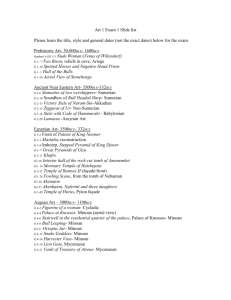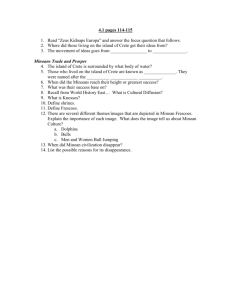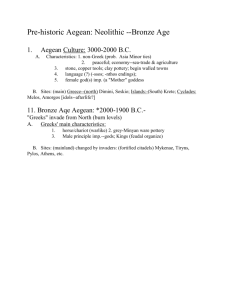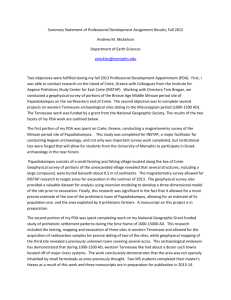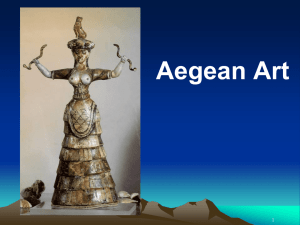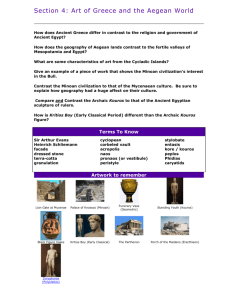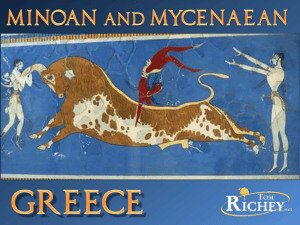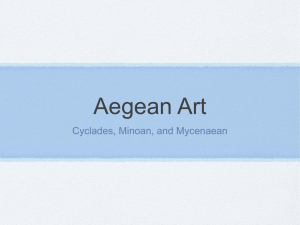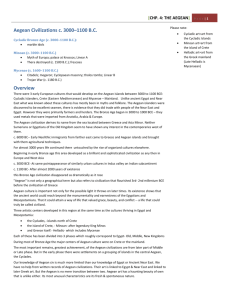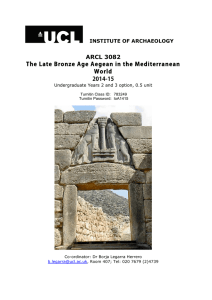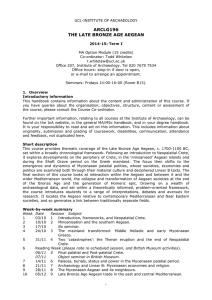View from the West: Why aegean archaeology Matters
advertisement
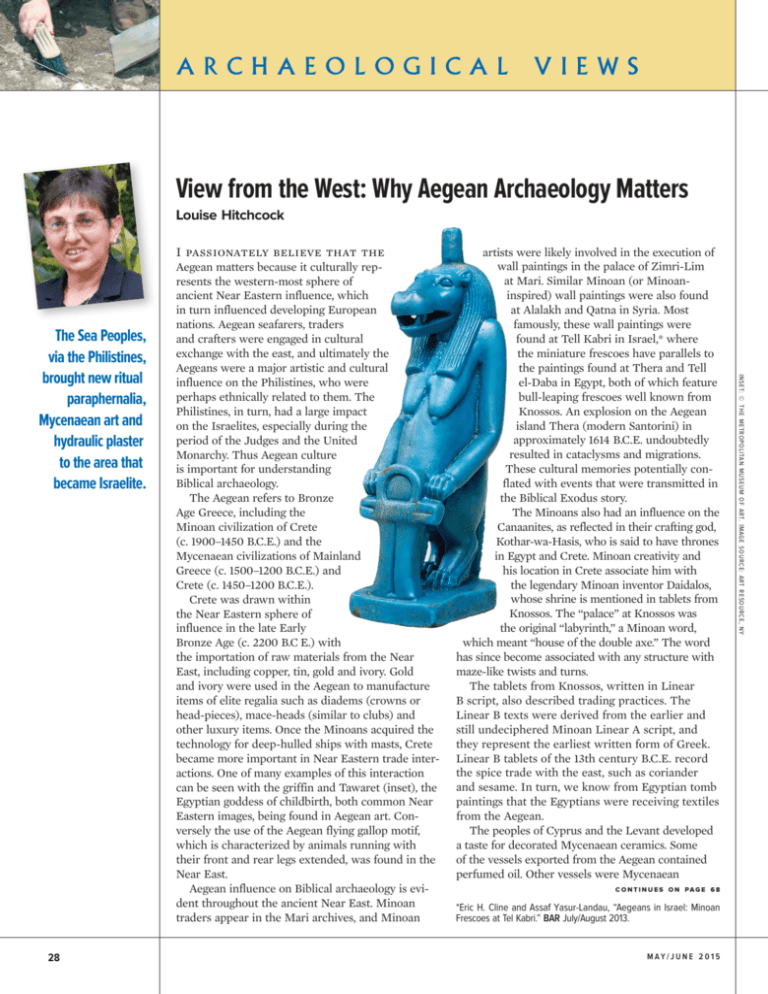
archaeological VIEWS View from the West: Why Aegean Archaeology Matters Louise Hitchcock I passionately believe that the 28 artists were likely involved in the execution of wall paintings in the palace of Zimri-Lim at Mari. Similar Minoan (or Minoaninspired) wall paintings were also found at Alalakh and Qatna in Syria. Most famously, these wall paintings were found at Tell Kabri in Israel,* where the miniature frescoes have parallels to the paintings found at Thera and Tell el-Daba in Egypt, both of which feature bull-leaping frescoes well known from Knossos. An explosion on the Aegean island Thera (modern Santorini) in approximately 1614 B.C.E. undoubtedly resulted in cataclysms and migrations. These cultural memories potentially conflated with events that were transmitted in the Biblical Exodus story. The Minoans also had an influence on the Canaanites, as reflected in their crafting god, Kothar-wa-Hasis, who is said to have thrones in Egypt and Crete. Minoan creativity and his location in Crete associate him with the legendary Minoan inventor Daidalos, whose shrine is mentioned in tablets from Knossos. The “palace” at Knossos was the original “labyrinth,” a Minoan word, which meant “house of the double axe.” The word has since become associated with any structure with maze-like twists and turns. The tablets from Knossos, written in Linear B script, also described trading practices. The Linear B texts were derived from the earlier and still undeciphered Minoan Linear A script, and they represent the earliest written form of Greek. Linear B tablets of the 13th century B.C.E. record the spice trade with the east, such as coriander and sesame. In turn, we know from Egyptian tomb paintings that the Egyptians were receiving textiles from the Aegean. The peoples of Cyprus and the Levant developed a taste for decorated Mycenaean ceramics. Some of the vessels exported from the Aegean contained perfumed oil. Other vessels were Mycenaean c o n t i n u e s o n pa g e 6 8 *Eric H. Cline and Assaf Yasur-Landau, “Aegeans in Israel: Minoan Frescoes at Tel Kabri.” BAR July/August 2013. M ay / J u n e 2 0 1 5 Inset: © The Metropolitan Museum of Art. Image source: Art Resource, NY The Sea Peoples, via the Philistines, brought new ritual paraphernalia, Mycenaean art and hydraulic plaster to the area that became Israelite. Aegean matters because it culturally represents the western-most sphere of ancient Near Eastern influence, which in turn influenced developing European nations. Aegean seafarers, traders and crafters were engaged in cultural exchange with the east, and ultimately the Aegeans were a major artistic and cultural influence on the Philistines, who were perhaps ethnically related to them. The Philistines, in turn, had a large impact on the Israelites, especially during the period of the Judges and the United Monarchy. Thus Aegean culture is important for understanding Biblical archaeology. The Aegean refers to Bronze Age Greece, including the Minoan civilization of Crete (c. 1900–1450 B.C.E.) and the Mycenaean civilizations of Mainland Greece (c. 1500–1200 B.C.E.) and Crete (c. 1450–1200 B.C.E.). Crete was drawn within the Near Eastern sphere of influence in the late Early Bronze Age (c. 2200 B.C E.) with the importation of raw materials from the Near East, including copper, tin, gold and ivory. Gold and ivory were used in the Aegean to manufacture items of elite regalia such as diadems (crowns or head-pieces), mace-heads (similar to clubs) and other luxury items. Once the Minoans acquired the technology for deep-hulled ships with masts, Crete became more important in Near Eastern trade interactions. One of many examples of this interaction can be seen with the griffin and Tawaret (inset), the Egyptian goddess of childbirth, both common Near Eastern images, being found in Aegean art. Conversely the use of the Aegean flying gallop motif, which is characterized by animals running with their front and rear legs extended, was found in the Near East. Aegean influence on Biblical archaeology is evident throughout the ancient Near East. Minoan traders appear in the Mari archives, and Minoan A u thors Archaeological Views continued from page 28 Rachel Hachlili (“Synagogues—Before and After the Roman Destruction of the Temple,” p. 30) is professor of archaeology at the University of Haifa, Israel, and author of Ancient Synagogues—Archaeology and Art: New Discoveries and Current Research (Leiden: Brill, 2013). She has written extensively on ancient Jewish art and archaeology in Israel and the diaspora, as well as on Jewish burial practices. Hachlili Zaraza Friedman (“Iconoclasts and Fishermen—Christian Symbols Survive,” p. 40) is an independent scholar. Her research interests are in ship iconography in mosaics, ancient harbors, ancient nautical archaeology and seaway trade. Lawrence H. Schiffman (“A Short History of the Dead Sea Scrolls and What They Tell Us,” p. 44) is currently the Judge Abraham Lieberman Professor of Hebrew and Judaic Studies at New York University. A specialist in Judaism in Late Antiquity, the history of Jewish law and Talmudic literature, as well as the Dead Sea Scrolls, he was formerly chair of the Schiffman Skirball Department of Hebrew and Judaic Studies at New York University. He is a past president of the Association for Jewish Studies. Friedman “For the message of the cross is foolishness to those who are perishing but to those of us who are being saved it is the Power of God Corinthians 1:18 BUTTERFLY WING ART JEWELRY BY POPPY Enlarged to Show Detail www.jewelrybypoppy.com 3769 Tuxhorn Rd. Springfield, IL 62712 68 217.679.3060 kraters—intended for mixing wine and water—which were repurposed by the Canaanites as beer jars in the Late Bronze Age. In the Levant, a market existed for the local production of Aegean-style ceramics. This need was filled by migrating potters who sought new patronage after the destruction and collapse of the Mycenaean palace systems (c. 1177 B.C.E.). This destruction and collapse resulted in further migration, as Aegean peoples and others from throughout the Mediterranean became entangled in the pirate cultures that resulted in the Sea Peoples phenomenon. One tribe of the Sea Peoples, the Peleset, settled in the southern Levant and became identified with the Philistines in the Hebrew Bible, while other groups of Sea Peoples settled throughout the Mediterranean—spreading Aegean artistic and cultural practices everywhere they went. The Biblical tradition associates the Philistines with the Cretans (Cherethites and the Kittim of Cyprus). A modern theory is that multicultural groups settled among the indigenous Canaanites in the southern Levant and evolved into a vibrant new culture that became known as the Philistines. These peoples introduced new ritual paraphernalia, colorful Mycenaean-style ceramics, iron-working technology, hydraulic plaster, the Mycenaean-style hearth with the hall house and new cuisines to the region. We can state with certainty that the Philistines were a sophisticated and artistic culture, unlike the stereotype of them as uncouth or uncultured perpetuated by popular understandings of the Old Testament. Still, the extent of Aegean influence on the Near East as well as the extent of Near Eastern influence on Greece remains a contentious area of investigation that continues to generate enthusiastic scholarly interest and lively debate. Louise Hitchcock is an associate professor in the School of Historical and Philosophical Studies at the University of Melbourne. She has excavated in Israel, Egypt, Syria, Crete and California. She specializes in Eastern Mediterranean archaeology. M ay / J u n e 2 0 1 5
